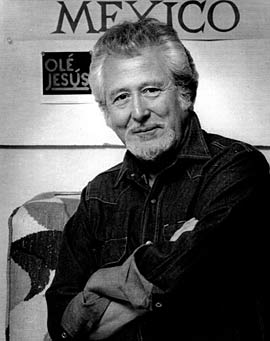UC Berkeley Press Release

Bancroft Library archiving works of pioneering artist Gus Arriola
BERKELEY – The "Gordo" comic strips, which beginning in 1941 introduced millions of people in the United States to life south of the border, is part of the rich archive of cartoonist Gus Arriola's work now residing at the University of California, Berkeley's Bancroft Library.
 Gus Arriola (Photo courtesy Robert C. Harvey) |
"These papers will be a wonderful source for anyone working on Mexican-American culture from the 1940s through the 1980s," said Charles Faulhaber, Bancroft director and a professor of medieval Spanish literature. "They introduced Mexican culture to huge numbers of people who previously knew it only through the stereotypes in movies."
"Gordo" was a regular newspaper fixture from 1941 to 1985. The syndicated cartoon's colorful cast of characters included, but was not limited to, Gordo Lopez, a charming and flirtatious farmer-turned-tour guide; Gordo's spunky nephew Pepito; his housekeeper and eventual romantic interest Tehuana Mama; poet Paris Juarez Keats Garcia, who wore Arriola's trademark beanie; and a menagerie of pets that included Poosy Gato, Señor Dog, spiders, ants, ladybugs and a "stand-up chameleon."
Arriola used authentic cultural elements - such as the annual Mexican observance of the Day of the Dead - and presented them in ways that appealed to a largely non-Hispanic audience. Over time, "Gordo" evolved from stereotypes to more enlightened yet witty, sassy, sometimes saucy and even sublime depictions of contemporary Mexicans, Mexico and Mexico's borderlands.
The strip also was considered unique because it alternated between gags and ongoing comedic story lines.
Faulhaber began reading "Gordo" after moving to California in 1969 and said he loved "Arriola's humor and his art work and, as a Hispanist, I always appreciated his portrayal of Mexican culture."
The strip has been honored by both the Mexican government and the California Legislature for promoting international understanding. In 1999, it earned the San Francisco Museum of Comic Art's Charles M. Schulz Award for lifetime achievement. Arriola received the National Cartoonists Society's Best Humor Strip honor in 1957 and 1965 and the 1981 Inkpot Award at the San Diego Comic-Con, a yearly convention.
Some of Arriola's well-known contemporaries included "Peanuts" artist Charles Schulz and "Dennis the Menace" creator Hank Ketcham. At its peak, "Gordo" was syndicated in 270 newspapers, primarily in the West.
Arriola stirred things up when he offered via the comic strip free copies of his family recipes for "Gordo's Beans Weeth Cheese" and chili con carne. An enormous reader response stunned unprepared newspaper staff. In addition to his culinary interests, Arriola expressed a passion for nature and acknowledged the influence of author Rachel Carson's 1962 book, "Silent Spring," which inspired widespread public concern about the environment.
The Bancroft Library will host a campus event in honor of Arriola on Thursday, March 6. In addition, the California Legislature is proclaiming "Gus Arriola Day" on the same date.
Arriola was born in Florence, Ariz., and graduated from Manual Arts High School in Los Angeles in 1935. Other Manual Arts graduates include artist Jackson Pollock, World War II aviator Jimmy Doolittle and Goodwin Knight, California's 31st governor.
Arriola began doing animation with the Charles Mintz Studio in Los Angeles before moving to the cartoon studio of Metro-Goldwyn-Mayer, where he met his wife, Mary Frances. He launched "Gordo" in 1941, taking a hiatus from the daily strip while serving in a motion picture unit of the U.S. Army Air Forces during World War II and submitting comic strips only for the Sunday papers.
The demands of self-employment and a daily comic strip prevented Arriola and his wife from venturing into his father's homeland of Mexico until 1961, said Bancroft archivist Lauren Lassleben. But their first trip was followed by many, she said, as Gus Arriola encountered firsthand the folk art, festivals and cultural traditions of Mexico.
"They just fell in love with it (Mexico) - the designs, the antiquities, the culture, the language," Lassleben said, recalling her conversations with the Arriolas.
Gus Arriola retired the cartoon in 1985. After Arriola's death earlier this month at age 90, Hector Cantu, co-creator of the syndicated comic strip "Baldo," which features Latino characters and themes, told the journal Editor & Publisher that "Gus broke ground for Latino strips. He was a tremendous inspiration..."
In online condolences accompanying Arriola's obituary in the Monterey (Calif.) Herald, one reader from San Antonio, Texas, wrote that she read "Gordo" every day for years, "and the stories and characters influenced my attitude towards Mexicans by showing we have the same hopes, struggles, friends and families."
The Bancroft Library is home to manuscripts related to the exploration and settlement of the territories from Florida to California, personal records related to the Mexican-American War, as well as letters, pamphlets and books from key figures in the Mexican Revolution such as Porfirio Díaz, Francisco "Pancho" Villa and Emiliano Zapata, the university's archives, the Mark Twain Papers, and more. Its collection includes more than 500,000 books, 50 million documents, more than 8 million photographs and negatives, and maps, photos and diaries. Half of those who use the collection are students.


